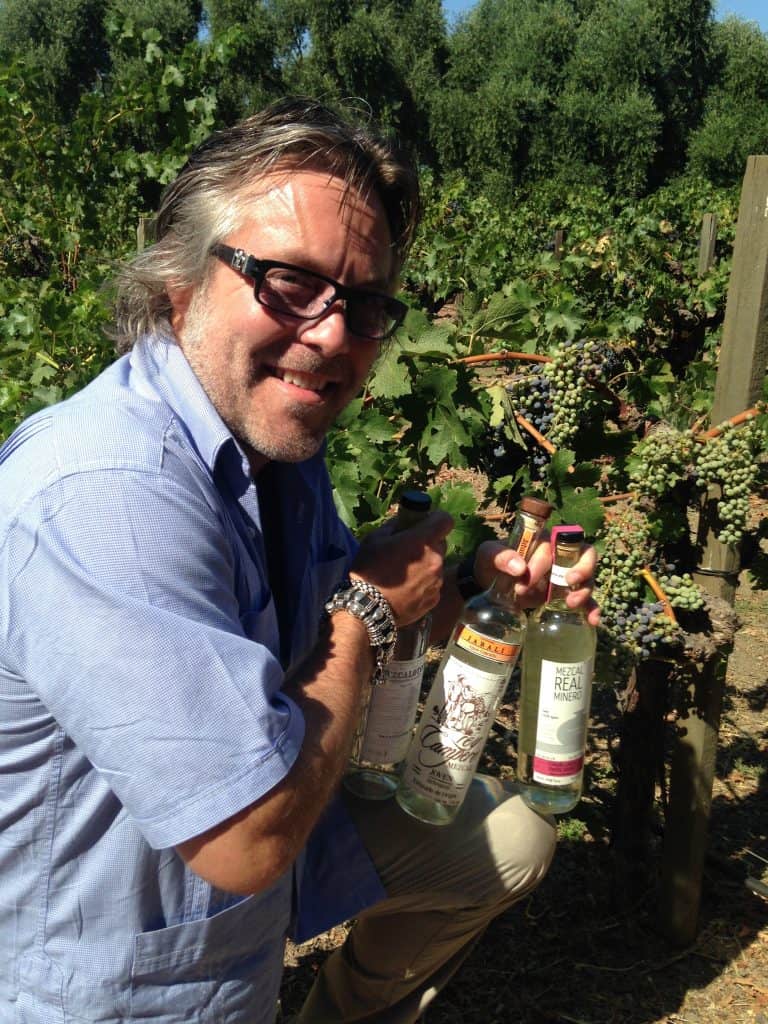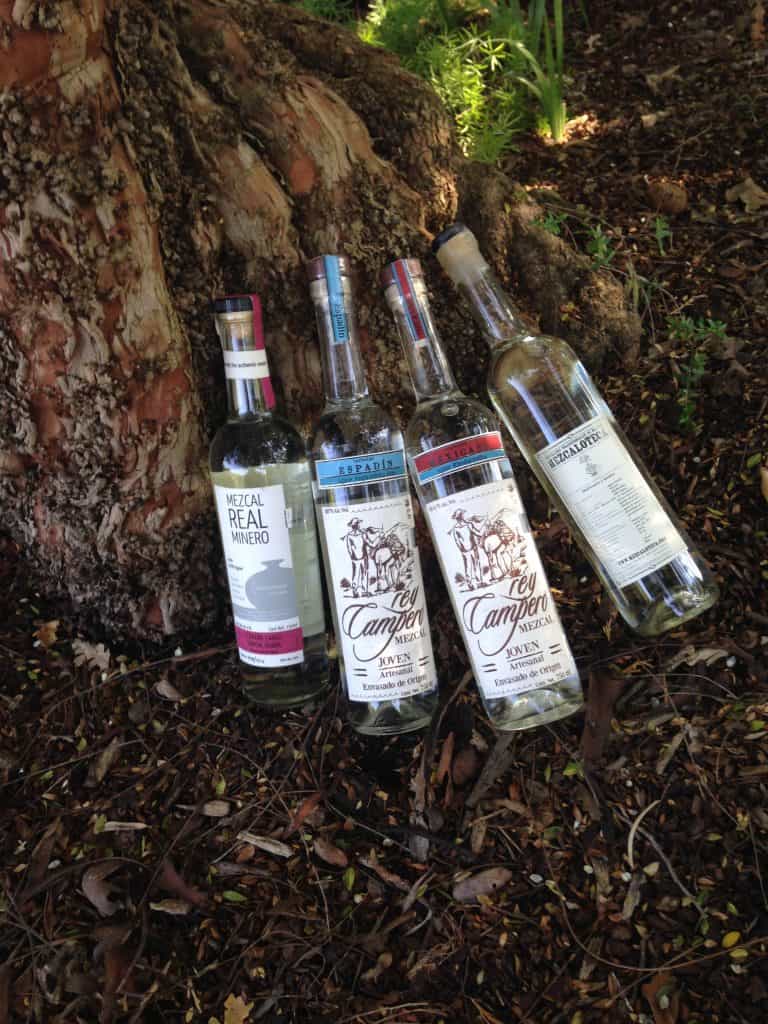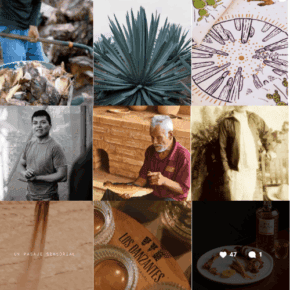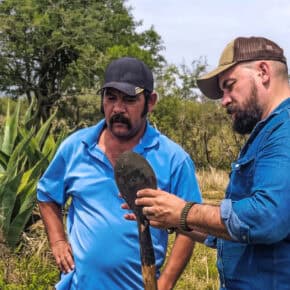
William Scanlan has been a man on a mission for quite some time. You may have seen him toting bottles of Real Minero, Rey Campero, and Mezcaloteca to tastings across the United States. Now you will see those bottles independent of the bespectacled man at bars, restaurants, and on the shelves of better liquor stores across the country because William’s quest to bring them to North America is finally certified and legal.
His story has many of the elements common to mezcal and opera: He met mezcal, fell into a torrid romance, and spent the rest of the dramatic acts resolving all the problems. In his case it was the work of importing and distribution which, as many others similary bewitched by mezcal can attest, is more than a simple chore. But the time and effort involved probably made him better prepared for the road ahead. It’s not easy out there for a mezcal importer.

First, the mezcal
Before we do anything else let’s get to the serious stuff. The mezcals. Here’s what’s being imported to Texas by Virtuoso Selections, Washington by Agave Oaxaca, and fresh this week, California courtesy of JVS Imports. As William’s import company, the aptly named Heavy Métl, gets its tentacled arms across the country he will open more states with strategic partner Skurnik Wines starting with New York in October.
Real Minero
DOM Santa Catarina Minas
NOM O37X
Maestro Mezcalero: Don Lorenzo Angeles
– Barril (Agave Karwinskii)
– Largo (Agave Karwinskii)
– Field Blend of 4 agaves (barril, largo, and tripon from the Karwinskii team and espadin, Agave Angustifolia haw.) This is the sort of blend that probably comes closest to recreating the original mezcals. Traditionally mezcals were made from whichever mezcals were ripe at the time of distillation and less emphasis was placed on type.
– Pechuga: Triple distilled espadin (Agave Angustifolia haw.) with the addition of creole/wild apples, pineapples. platano de castilla, orange, almonds, white rice, the skinless breast of a free range chicken that hasn’t laid eggs, and more.
– Arroqueno: (Agave Americana var. Oaxacensis) Though this was an extraordinarily limited production run of 65 liters for Real Minero’s launch in the United States. It’s heavily allocated so don’t be disappointed if you can’t find any.
Rey Campero
DOM – Candelaria Yegole
NOM – O185X
Maestro Mezcalero: – Romulo Sanchez Parada
– Espadin (Agave Angustifolia haw.)
– Cuishe (Agave Karwinskii)
– Madreuishe (Agave Karwinskii)
– Tobala: (Agave Potatorum) This is the only Rey Campero mezcal made from wild agave harvested from a different village, San Pedro Martir at about 6000 feet above sea level. The high altitude and cooler climate favors tobala from San Pedro Martir but only during the dry seasons because these plants are especially sensitive to rain.
– Mexicano (Agave Rhodacantha)
– Jabali (Agave Convallis)
– Tepextate: (Agave Marmorata) This just arrived in the United States and is now available in California but it will take a little longer to get distributed everywhere else.
– Later this year William plans to import Rey Campero’s Arroqueno (Agave Americana var. Oaxacensis) and Sierra Negra (Agave Americana), ideally as something special for the holidays so start saving now!
Mezcalosfera by Mezcaloteca
William is working away on bringing Mezcaloteca’s various bottlings into the United States. The name is different because it reflects Marco Ochoa and Silvia Philion’s idea to distinguish between certified and non certified mezcals. William will only be importing certified mezcals. At least for now! With luck we’ll start seeing these bottles later in October just in time to snap them up for holiday gifts!
Who is William Scanlan?
Like many of us William fell in love with mezcal and immediately set to work figuring out how to make it part of his life. A native Texan and fluent Spanish speaker, he’s lived on both sides of the border for his work. He first encountered mezcal 12 or 13 years ago at his local Mexican restaurant in Austin where he’d hang out and sample the latest tequilas with the staff. One day the manager told him “‘come in tomorrow night for a mezcal tasting, you have to taste it, it’ll change your perspective and you’ll never like tequila again.’ I thought that was a bold statement so I showed up and the man leading the tasting happened to be Ron Cooper. Back then he was still driving mezcal up from Oaxaca himself. I hung out and talked to him for a while and that’s really when I first became enamored with mezcal. I had never tasted that level of quality before.” For anyone that doesn’t know, Ron Cooper is the founder of Del Maguey, the original artisanal mezcal in North America.
The mezcal obsession really got going in 2006 when he moved to Oaxaca and later Mexico City. He’d been mulling the idea of his own mezcal brand and traveling to all the mezcal meetings at Agave Fest, Expo Mezcal, Dardo, and anywhere else that would help him learn about the spirit and the industry. Then two years ago his good friend and mentor, Erick Rodriguez of Alma Mezcalera, grabbed him at Agave Fest and told him that he really needed to taste this new mezcal called Rey Campero. “I went over and tasted them and it was right then and there that I broke the idea of doing my own brand. I decided that being an importer was what I wanted to do because it was much more than about the brand, it was about the culture, regions, biodiversity, and traditions of the families that produced these mezcals.”
What’s the Rey Campero story?
Rey Campero is the perfect example: The brand is really a family of brothers, cousins, and nephews – Romulo is their maestro mezcalero in the community of Candeleria Yegole about two hours south-west of Oaxaca City. The village may be familiar to you because Mezcal Vago hails from the same area as do many smaller producers. Romulo learned how to make mezcal from his dad and worked in the palenque until he was 20 but, like many people in his village and the whole country, when the economy went bad and mezcal wasn’t a viable business he emigrated north and worked in North Carolina.
When Romulo returned to Mexico in 2003 he moved to the City of Oaxaca and thought about returning to the mezcal business but it wasn’t until 2012 that he made the leap, moved back to Candeleria Yegole and got the business started. He pulled his brothers and nephews into the project and they have been working away at it ever since. The fact that they’ve really only been a formal company since 2012 tells you everything you need to know about the evolution of mezcal; it’s young and growing fast.
Romulo and his family still do everything on the production side even if many of them live in the city of Oaxaca. As William told me, “they prepare the ovens, roast and plant the agave. They may be in charge of sales and administration but they’re actively involved in the grunt work.” And that tradition shows through in the mezcals: Almost all of them are truly the fruit of wild agaves with their espadin being the only cultivated one of the bunch.
As for the name, Rey Campero means “King of the Countryside” and was chosen to reflects the landscape, hard work, wild agaves, and “superior mezcals” that the brand produces. William told me that the connection to the countryside is critical to all concerned because “it’s a reference to the difficulty of harvesting maguey from the steep slopes and canyons in the countryside where you can not use trucks to remove the maguey.” In other words, Rey Campero runs on the backs of its farmers and burros.

Becoming Real Minero’s conduit
Anyone who has tasted Real Minero knows how good they are. Graciela Angeles Carreño is the leader of the brand and an upholder of a family tradition. She fully understands the weight of that burden and has defined her family’s business and distilling tradition with a precision and discipline seldom seen in the mezcal business. William said that when he first visited her palenque, “it blew me away how clean and organized the palenque was. I told her ‘this is incredible, it’s the most organized and most clean palenque I’ve ever seen,’ and she told me “this is what happens when you have a woman in charge of running a business.””
Working with Real Minero took time and lots of intention exactly because it’s a family business with so much at stake. Like many of these things it’s all about the relationship. When William first met Graciela she was entertaining offers from a variety of importers. Whatever he offered her and represented must have resonated because he ended up with the contract. As he puts it “Ultimately, she decided to work with me, I’m very grateful for that.” Having met both William and Graciela my guess is that they have something like an extended familial relationship of fantastic respect and understanding which is the foundation of the business.
Anyone who has met Graciela can testify to the precision and care she brings to the business. The same goes for her entire operation, Real Minero produces just 5,000 liters a year for the Mexican and European markets. The plan is to slowly ramp up with demand from the United States while maintaining high quality in their low production.
Mezcaloteca rising
If that wasn’t enough, Heavy Métl will soon bring select Mezcalosferea by Mezcaloteca bottles into the U.S. Mezcaloteca is the embodiment of cult status. Physically a tasting room in Oaxaca City just up the street from the botanical garden as well as a label which brings many small producers to the attention and delight of mezcal aficionados fortunate enough to make the trip. They represent much more, founding member Marco Ochoa is one of the intellectual guides for the mezcal world while his business partner Silvia Philion continues to run the show. Screaming Eagle eat your heart out because you can still go to Mezcaloteca and meet the people behind the brand with their products nightly. Bringing that vibe and product north is a trick – so much so that there won’t be many bottles and they will be few and far between; as in real collectors items. As William says, “The idea is to keep production low and maintain the true sense of Mezcaloteca, once it’s gone it’s gone.”
Mezcaloteca’s bottles are famous for their exact descriptions of who produced the contents and how. They adapted a traditional structure and have paved a path for the rest of the industry. Their focus has always been on the purely artisanal producers who, by necessity, only create small batches because other things like stable incomes derived from farming cash crops take priority. And, because they’re so small, most of Mezcaloteca’s producers aren’t certified by the CRM as makers of mezcals. William told me that only a single Mezcaloteca producer is currently certified so he’s working with Marco and Silvia to build a new collaborative palenque. “we’re creating opportunities for people in the community who would like to certify their production – like this 22 year old kid who is making amazing mezcales at his father’s palenque but since his dad is against certification he has no where else to go to certify his mezcal. So we want to give opportunities to people who want to be certified and are faced by certain obstacles.” Given that state it’s going to be a while before Mezcaloteca’s bottles start appearing in the United States; optimistically this fall, realistically the new year. Hope in the mezcal world springs eternal.
The future
I’d be remiss if I didn’t talk about the name because it’s just so awesome. No, William isn’t a lover of Danzig, Metallica, or sundry other bands that could have inspired him naming his business “Heavy Métl” which, in this new variant of Nahuatlish or Englitl, is the perfect combination of North American pop sensibility and the Nahuatl word for agave. Nahuatl being the language common to the peoples of what is now central Mexico like the Aztecs, when the Spaniards arrived. The “Heavy” part harks back to the colloquial meaning in the seventies, as in “deep” or “profound.” It refers back to that idea of “that’s heavy man.” refers back to that. band reference. I’m at a loss, why didn’t we or anyone else think of it. But William has it sewn up, he gets the cred for that and gifting himself with the title “Chief Mezcalhead.”
Heavy Métl has been nearly a decade in the making and just started importing this summer so I’d expect things to ramp up slowly but it sounds like William has been overwhelmed with orders and is sitting on top of a successful operation. As he told me last week “my projections were way too conservative which is really exciting for these families and me.” He’s been so busy supporting the few states where Heavy Métl already imports that he’s only been able to go to Mexico for a few days in recent months. Sounds like it’s high time for a new hire, but he isn’t resting on his laurels just yet. He told me that Oaxaca is just the beginning. “I’m starting with mezcal from Oaxaca because that’s where everyone thinks where mezcal comes from so I decided to bring the best of the best. I’m building my name as an importer, but the only reason I’m trying to draw attention to myself is so that when I plop another amazing mezcal down in front of a consumer from Guerrero, San Luis de Potosi, Durango, or somewhere else, there will be some consumer awareness that ‘this is the guy who brought Mezcaloteca, Real Minero, or Rey Campero, I’m going to trust him.’ I need to develop that confidence and trust before I can expand.”
And expansion is clearly on his mind because one of the last things he said was “Part of this project is rooted in me getting tired of drinking the same mezcales every time I came to the United States. It’s rooted in my experience and education. Not that stuff here is bad, there are some great mezcales, but I feel that mezcalophiles want new stuff.” The rumors of what that ‘new stuff’ might be are incredibly enticing, more as we can confirm it…












Leave a Comment